Blog Post
Measuring the Effectiveness of Cyber Security GRC
February 17, 2025
TL;DR
- Cyber security GRC programs have the potential to drive operational efficiency and market success, offering tangible benefits like reduced costs from minimized cyber risk exposure, lower regulatory penalties, and optimized spending based on objective data.
- Intangible benefits of cyber GRC frameworks include better alignment between cybersecurity and business goals, strengthened board confidence, and enhanced organizational resilience.
- One key challenge of a cyber GRC program is demonstrating its value. Nevertheless, it’s crucial to do so in order to gain executive buy-in and secure adequate funding and support.
- On-demand cyber risk quantification (CRQ) platforms can help in this aspect, helping security and risk management (SRM) leaders demonstrate measurable outcomes, thereby transforming GRC in cyber security into a strategic asset.
- Quantifying ROI through metrics like average annual loss (AAL) provides clarity to non-technical stakeholders on cyber security GRC's financial impact and justifies investments.
- Regularly aligning cyber GRC initiatives with business objectives ensures they remain adaptable and integral to long-term success.
Breaking the Cycle: Elevating Cyber Security GRC to a Strategic Asset
Cyber security governance, risk, and compliance (GRC) programs are often viewed as cumbersome - a necessary yet costly component of doing business, providing very little value to the organization in terms of strategic impact. This narrow perception, unfortunately, limits the plethora of opportunities that a robust cyber security GRC framework would otherwise unlock. Indeed, far from being a cost center, a solid program has the potential to significantly drive operations forward and even lead to a competitive market edge.
The core challenge that many organizations face when justifying the benefits of GRC initiatives, however, lies in being able to quantify the returns, which, subsequently, results in not being able to communicate with senior executives and board members. Without their support, the GRC is undoubtedly severely underfunded and, likewise, undervalued, further entrenching the negative feedback loop and cementing the program's position as second to that of other business priorities.
To break the seemingly neverending cycle that companies often fall into, cyber security and cyber GRC program leaders must start focusing on articulating the measurable returns of their efforts, both tangible and intangible. Leveraging solutions like on-demand cyber risk quantification platforms can assist these executives in this endeavor, equipping them to demonstrate initiative outcomes in a manner that facilitates greater investment and confidence and transforms GRC from a mere necessity to a catalyst for long-term success.
The Misconceptions Holding Back Cyber GRC Programs
Cyber GRC is a framework that helps organizations systematically combine governance, risk management, and compliance processes in the context of the digital realm into a single, cohesive project, ensuring that related efforts are aligned both internally and with higher-level business objectives. Not only do these large programs safeguard sensitive data and keep track of compliance efforts, but they also serve as means by which to demonstrate accountability to key stakeholders and regulators.
Despite the critical role they play, such programs are often seen as shallow, serving as a checkbox that needs completion. Moreover, their large-scale nature, encompassing multiple departments and demanding considerable time and capital, leads many to believe that cyber GRC is a resource drain rather than a value driver. The focus on meeting regulatory standards similarly fosters this unfavorable position, as efforts are considered to be reactive rather than proactive or innovative.
Bridging this divide requires a shift in how GRC initiatives are presented. As opposed to focusing solely on technical or legal "metrics," SRM leaders must prioritize showcasing outcomes that resonate with the C-suite and board members. When GRC is finally communicated in measurable terms that speak to organizational aspirations, such as financial stability and operational efficiency, securing the support and resources becomes far more attainable.
Articulating the Tangible Benefits of Cyber GRC
One of the most compelling ways to demonstrate the value of a cyber GRC program and gain executive support is by focusing on its tangible benefits, those that can be measured directly and communicated in terms of financial and operational outcomes. With the right metrics, GRC teams are equipped to position their initiatives as strategic investments that contribute directly to financial resilience.
Reduced Costs from a Decrease in Cyber Risk Exposure
A robust cyber security GRC program sets the foundation for assessing and, subsequently, managing the forecasted consequences of cyber risks before they materialize. Common management tactics include internal security control upgrades, the implementation of new technology, and third-party risk transfer. These strategies reduce both the likelihood and severity of potential incidents, such as data breaches and ransomware attacks, which carry direct costs.
With the eight companies out of the S&P 500 facing a 10% probability of experiencing a loss of 10% of annual revenue in the upcoming year, proactively minimizing these events is the key to achieving substantial financial savings.
Minimized Potential for Regulatory Penalties
Non-compliance with regulations can lead to massive fines and expensive legal responsibilities that drain more resources than might have otherwise been spent. For instance, if found in violation of the EU's NIS 2 Directive, essential entities can be fined, at minimum, 2% of their global revenue: an amount some might even consider to be material. The US SEC, similarly, has already demonstrated its propensity for levying significant penalties for non-compliance with its cyber security legislation. By proactively and systematically addressing compliance requirements, organizations can save millions annually.
Optimized Spending Decisions Based on Objective Data

When quantified insights drive GRC frameworks, stakeholders gain access to more reliable data regarding their organization's financial exposure due to cyber risk, allowing them to make more informed spending decisions and, thus, reduce waste. On-demand CRQ harnesses external global intelligence from dozens of data sources to calculate figures such as the average annual loss (AAL), providing the information necessary to allocate resources more effectively and ensure that exposure levels and capital reserves align with overall risk appetite.
Highlighting the Intangible Benefits of GRC in Cyber Security
Although the more tangible benefits of GRC in cyber security are typically used as the indicators of the program's success, its less tangible merits can still be leveraged to communicate the broader impact on organizational resilience. These intangible outcomes further help to position GRC as a business enabler amongst decision-makers and ensure that adequate resources are allocated to respective initiatives.
Greater Alignment Between Cyber Security and Business Goals
When GRC efforts are well documented within a cyber risk register, it's easier for SRM leaders to recognize how specific risk mitigation and compliance actions can align with broader business objectives. Moreover, this structured documentation facilitates discussions with stakeholders, similarly helping them understand how pursuing specific initiatives bolsters operational efficiency and consistent growth. When everyone is on the same page, cyber security GRC is more likely to be incorporated and viewed as a strategic asset.
Strengthened Board Confidence Through Clear, Actionable Reporting
A strong cyber GRC program demonstrates accountability and transparency, which builds trust amongst stakeholders, including customers, investors, and regulators. Organizations that make an effort to prioritize cyber security from multiple angles send a clear message about their commitment to safeguarding sensitive information. Such actions reinforce their credibility and position them as reliable and forward-thinking leaders in their industry. As the rate of cyber events increases, this reputation is going to increasingly become a key differentiator amid a highly competitive marketplace.
Calculating Cyber Security GRC Return on Investment (ROI)
Quantifying the ROI of cyber security initiatives has long been a challenge for practitioners. However, as cyber risks increasingly intersect with business operations, the need to translate these outcomes into financial terms has become critical. This growing demand has driven the adoption of tools like on-demand cyber risk quantification (CRQ). CRQ analyzes an organization's unique vulnerability to cyber risks and translates it into financial terms, enabling stakeholders to measure the effectiveness of risk mitigation and compliance efforts.
Harnessing metrics such as the AAL, a figure that reveals an organization's expected average financial loss in the upcoming year due to cyber events, organizations can easily determine how their proposed GRC program will impact its overall risk posture. For instance, if at the start of a quarter, a CRQ forecasts the company's AAL at $4 million, but by the end of the same period, it has decreased by 50%, the GRC initiatives implemented during that period can be credited with reducing financial exposure. Moreover, this amount can be compared with the cost of investment, providing a clear picture of ROI.
In addition to assessing broader financial risk and GRC program ROI, CRQ can also pinpoint the financial benefits of specific security control upgrades. For example, in Figure 2, Kovrr's CRQ platform demonstrates that while operating under ISO 27001 compliance standards, upgrading User Endpoint Devices controls from 'Partially Implemented' to 'Fully Implemented' enables ServiceMinds Inc. to reduce their financial exposure, on average, by $258 thousand. The platform further calculates that, given the cost of implementation, the initiative would deliver a 3% positive ROI.

While they are hardly the only use cases for which CRQ can be harnessed to calculate ROI for a cyber GRC program, these examples nevertheless provide a clear indication of its potential. Translating cyber security efforts, be they risk management, governance, or compliance-related, into financial metrics, cyber risk quantification can offer stakeholders the information necessary for determining cyber's direct monetary value. This data-driven approach not only justifies investments but also helps to strengthen the future integration of cyber initiatives into high-level strategic operations.
Best Practices for Aligning Cyber Security GRC With Business Objectives
For the cyber security GRC program to deliver maximum value to the organization, it has to be aligned with the higher-level objectives, ensuring that GRC initiatives are not viewed as isolated side tasks but as integral components of the company's strategy that drive growth and resilience. Achieving this alignment starts by engaging with C-suite executives early on in the GRC creation process, discovering what their priorities are and finding ways to interweave them with cyber security aims.
Regular communication with these executives as the program is carried out is equally essential for maintaining alignment. As the business grows and evolves, so too must cyber security GRC programs. Staying in touch with key stakeholders allows GRC program leaders to address emerging risks and concerns as they develop and adapt priorities accordingly. The ongoing dialogue also reinforces the importance of cyber GRC as a collaborative effort, fostering a culture in which cyber is recognized as a non-negotiable component of business success.
Financial metrics serve as a critical tool in this regard, offering a straightforward means of demonstrating how GRC outcomes can contribute to objectives from multiple departments. For example, by quantifying the financial impact of risk mitigation efforts, such as reducing potential monetary losses due to ransomware attacks, cyber security executives can provide a tangible connection between the GRC program and operational efficacy. It also highlights how cyber risk management can save otherwise lost resources, which can then be reinvested into other departments or areas.
Reimagining GRC: A Dynamic Driver of Business Success
Cyber GRC programs have long since evolved beyond their origins as mere checkboxes, serving now instead to bolster broader organizational resilience and long-term growth. In fact, far from being a burden, modern GRC initiatives are strategic assets for companies, capable of illuminating new areas for collaboration and driving measurable improvements in efficiency and trust when effectively implemented and aligned with higher-level objectives.
Unlocking this potential, however, requires security and risk management leaders to regularly engage with C-suite executives, using tools like cyber risk quantification to provide tangible metrics that foster meaningful conversations. By translating complex cyber outcomes into actionable insights, CRQ assessments highlight the tangible value of risk mitigation and compliance efforts. With the common language rooted in monetary transparency, CRQ enables decision-makers to see how GRC initiatives align with their departmental goals.
Adaptability is equally vital to capitalize on the benefits that a robust GRC program can provide. Regularly reviewing GRC frameworks ensures they remain valuable amidst evolving regulations, emerging threats, and growing governance policies. Furthermore, continuous updates help to embed GRC within the organization's culture, fostering a collective understanding of its importance and reinforcing the need for strategic investment at every level.
When approached strategically, cyber security GRC programs can become more than a safeguard—they can be the cornerstone of an organization's sustainable success and competitive edge.
To learn more about cyber security GRC, schedule a meeting with one of our cyber risk management experts today.





.webp)
.jpg)


